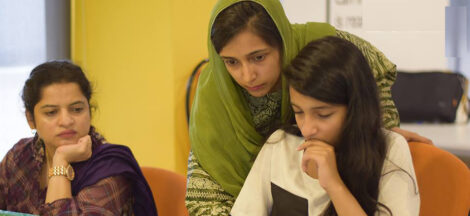Do you know what is common between San Bernardino’s shooting spree and the terrorist attacks in Paris last month? Jillennials, Jihadis who are Millennials.
We mine data worldwide, a lot of it, a ton of it, every day and every night, and we do this for a living at PredictifyMe. We have partnership with the United Nations to protect school-goers in Pakistan, Nigeria, Sudan and Lebanon using our proprietary software SecureSim™ and Soothsayer™. When the Paris attacks unfolded, we asked ourselves (and our database), how can we use data sciences to prevent something like this from ever happening again. Can we find out what factors influence an otherwise ordinary citizen to become radicalized? How long will it take? Is there any data to substantiate one country having more radicalized people over others? Can we run a simulation or train a deep learning neural network to find out what percentage of people is vulnerable for becoming radicalized? Can we come up with a formula that guarantees radicalization? What patterns can we find from the known radicalized people and their social behavior that stand out? And most importantly, what or who would be the next target?
We are glad that we did this exercise and found interesting insights. We have unearthed unique patterns and busted quite a few myths related to social media, youth radicalization and ISIS. Our results are promising and we are building a model to launch the product on a global scale. However, there is a caveat, being a bunch of data scientists who prefer books and open datasets, our view is only restricted to data that we can find, mine, and compute. We are not experts on social sciences, politics, online jihad, Islamophobia, Europe, or militancy.
Predicting the probability of the location of an attack is a hard business. There are several factors and a plethora of open datasets that go into our algorithms to yield results, if any. Each country is different, and has its own atmosphere of support and cure that flourishes or diminishes the probability of youth radicalization and subsequent terrorist attacks. But, there are few parameters and indicators that serve as a baseline to solve this problem.
We would classify these factors into five groups:
- Country Readiness to Support Terrorism: Population, population break-up, non-citizen immigrant population and their countries of origin, popular sect of Islam in their home countries (Salafi, Wahabi, Shia, Sunni etc.), GDP, Human Development Index, violent activities and protests in the past years, political, ethnic and religious conflicts, poverty, income disparity, military expenditures as percentage of GDP, country’s involvement and support in foreign conflicts etc.
- Jillenials: Percentage of youth population, their education, income, lifestyle, religious affiliations, political engagements, previous criminal records, percentage of youth in jails, convicted of crimes etc.
- Disengagement from the Society: Percentage of unemployed youth, percentage of unemployed Muslims, Percentage of Muslims in jails, Muslim unemployment versus country’s unemployment rate, percentage of youth and Muslims in managerial positions, percentage of Muslims in a country’s political system in proportion to their ratio in country’s population etc.
- Social Media: Population and patterns on social media, increase in joining terrorist groups and watching pro-ISIS videos, pro-radicalization Twitter accounts and their followers, social network analysis and between-ness centrality etc.
- Islamophobia: Anti-Islam sentiments, cartoon contests, restriction to wear hijab, damage to local mosques and Muslims graves etc.
We have approximately 80,000 Twitter accounts to analyze that are pro-ISIS. With Anonymous campaigns to rage a cyber-war against ISIS, our work gets more complicated to keep track of dead accounts and the addition of new ones. Cyber warfare has reduced the overall age of terrorists twitter accounts from 8 months to 67 days only. This is a lot of data to collect and process. After all of these considerations, our deep learning neural network goes like this. If a country hasx1 % of a single ethnic/religious group in jail, x2 % living under the poverty line,x3 are uneducated, x4 is the unemployment rate for the ready-to-radicalized population, whose average age is x5 years old, we have y % of the population, ready to be radicalized over z period of time.
All of the attackers in the France carnage were in their twenties, both of the attackers of San Bernardino were in their twenties as well, so are the majority of attackers in Europe post 2008, from the attack on Frankfurt airport on US soldiers’ shuttle, to the 7/7 subway bombings of London, as well as the actors behind many more foiled attacks. Millennials (Jillennials) become a good point to start our data exploration for understanding what they do differently that would help us pick their patterns and behaviors online.
Millennials are the growing population worldwide. There are 84 million millennials alone in the US that drive US$ 200 Billion in retail sales per year. They are digital natives, the way they make friends, trust, live, do business and get into relationships are totally different from their previous generations. And they have been told over and over again that they can do anything. They are addicted to cell phones and social media. They believe in public-internet-life, have no brand loyalty, only cares about quality and service, have more brand engagement, and more than half of them do not associate themselves with any political party. They do not watch cable, but will go crazy without Netflix, Apple TV, Amazon Prime, or Sirius Radio. They do not read The Washington Post or New York Times in the morning, in fact, 88% get their newsfeed from Facebook. And they are not poor either, 11.8 million millennials in the US alone (between the age of 18 and 30) make more than US$100,000 per year. On the contrary, they also buy more because of social-peer-pressure and will be in debt sooner and at higher levels than their previous generations.
They are also quite different in other avenues. They are more connected to their parents than their parents were connected to their grand-parents; parents pay 59% of millennials’ cell phone bills and they don’t mind returning to their parent’s house and asking for financial help. Twenty-eight percent of millennials get married between the age of 18 to 32 versus 48% of the baby boomers generation. They are less religious (36% versus 61% of boomers), less patriotic (49% versus 81%), surprisingly less environmentalist (32% versus 44%) and more supportive of LGBT rights (51% versus 32%).
We have found millennials in Europe have 250 friends on average on Facebook, while the people with probability of radicalization have less than 100. We found 55% of European Facebook users share their selfies versus almost 1% for the second group of potential ISIS recruits. These millennials can spark a riot in less than two hours using twitter only, we call it #HashtagIncitements. If it is among the closely connected cohort of potentially radicalized youth, it can happen within 20 minutes or so.
There are plenty of myths associated with youth radicalization and social media. For example, radicalization only occurs in lower income segments (also referred to as ‘the poor”). Our data suggests otherwise. The best possible population to be radicalize comes from middle and high-income families.They are lone-wolf attackers without any connection to central authority. We believe it’s not true either. Clearly, they do not have a published org chart of their alliance and sympathies, but in the era of social platforms and online gaming, an artificial character in a war game can be the chief commanding officer and they can take orders, plan and rehearse the whole incident while playing with a group of teenagers. We can clearly see a life-less, emotion-free, emoticons-heavy artificial characters taking the seat of the next Ayman al-Zawahiri or Abu Bakr al-Baghdadi. While the players behind the character may change, the digital persona remains the same, thus providing an immortal inspiration to look up to. Radicalized people come from the devout religious population. Again, our data suggests otherwise. The majority transition from secular to radicalize. The people in this group do not attend local mosques or even talk to community leaders or neighbors or even the people from their home country. They sit in the dark, learning, and practicing online, until they are ready to do it once and for all. The majority of the radicalized people are off-the-radars for years.
And there is a reason for that. All of our security has been set up for individuals who are trained in Afghanistan or the Arabian Peninsula. This group is mostly uneducated, driven by religious ideologies, have less money and poor resources. In all of this mess, we forget the ones who are flourishing in our home countries; they know the language, know the system, are relatively more educated and financially stable (or can find the means to fund the plan, after all it’s the founders’ generation). The process of Radicalization is self-limiting. It’s the opposite actually. It is self-progressing. Even someone who does not find the courage to go out and launch an attack, helps by producing propaganda videos and distributing the planning material online. With dozens of Online Encouragements and a higher ordinance in the artificial chain of command (which is easier to do than in real life), it is a self-fulfilling prophecy that anyone can dream to become a commander in-chief of their own sleeper cell that does not exist in reality. Radicalization is more likely to happen in the first-generation migrants than others as they have participated in riots, violence and conflicts in their home countries. Not true really. First generation immigrants have a lot of ties back home, are connected with their communities, culture, food, and are usually more worried about the country back home than the county they are living in. Second, and third generations do not have that connection, their “home country” is the one they were born in and they don’t have strong ties back home. The identity they seek to live is not readily available from either of the countries and they feel very disconnected. When it comes to security, everyone thinks they understand Jillennials, as they have gone through this age and cultural shift too. However, they have no idea that these teens are not the same teens you were at that age. These are digital Jihadis and they have their own way of conducting themselves.
France is not as non-violent as it seems. There have been 1300+ violent incidents in France since 1968. French burn 40,000 cars per year in riots and violent activities. Since Charlie Hebdo shooting, 26 mosques have been vandalized in France. Seventy-four percent of French people see Muslims as intolerant and 27% have unfavorable views about Islam. Twenty-six percent population of the UK share the same unfavorable views, and the percentage continues rising to 33% in Germany, 46% in Spain, 50% in Poland, 53% in Greece and a whopping 63% in Italy. One in every four adults in France and Germany does not feel comfortable with Muslims. Based on the ethnicities and concentration of where these people live vis-à-vis Muslim population, we can easily calculate the neighborhood-at-risk index for each city in these countries.
Muslims are the youngest population in Europe. The median age of Europeans is 40 years; it is 42 for Christians in Europe, 37 for those with no religious affiliation and only 32 for Muslims.
France, Germany and Spain do not include religion in their census. We have gathered data from other secondary sources and open datasets for these countries. France has 6.3 million Muslims which is about 9.6% of the total population. The majority of them originate from North Africa (former French colonies). France also has a growing Muslim population from Sub-Saharan Africa and Turkey. France has an estimated 350,000 illegal immigrants. A million Muslims are added to the France population every 10 years since 1973, due to immigration, high birth rate of Muslims in France and French people converting to Islam. There are around 100,000 converts in France, 10% of these convert to Islam while in prison. The unemployment rate in France is 9%, but it is 14% for Muslims, 29.3% for Muslim youth and it increases to as much as 32% for Muslim youth with Algerian descent. Everything being equal, Muslims have a 2.5% less chance of being called for the interview of a managerial position over a non-Muslim French citizen.
Germany has 4.3 million Muslims (5.2% of the total population). The majority of them are Turks, and some of them are Turkish Kurds and from former Yugosalavia. Eighty percent of these Muslims do not have German citizenship. Their education is very low with only 14% having college degree. They are the least integrated in the society with an unemployment rate of 28%, compared to 4.7% for the country. The United Kingdom has 2.7 million Muslims (4.5% of the total population). The majority of them originate from South Asia and East Africa. Mohammad was the most common baby boy name in London in 2012. The Netherlands have 1 million Muslims (6% of the total population). Almost 70% are from Turkey and Morocco and the rest come from Afghanistan, Iraq and Somalia.
Let’s see how Muslims are doing in prisons. Muslims are 14.4% of UK’s prison population (while only 4.8% of country’s total population). That is 3 times their share in the population. The US prison population consists of 9% Muslims, compared to 0.8% Muslims in the overall population. This is 11 times higher (12% of US prisoners are non-citizens, New York has 17-20% Muslim prisoners). France’s prison population consists of 60% Muslims, compared to 8% of total population, 7.5 times higher. UK prison population has risen to 20% in last decade, while the UK Muslim population in prison has increased to 122% during the same time-period. Being Muslims in Europe is like Black in America. We need a Martin Luther King of Muslims in Europe!
So, what is next? We have found numerous patterns that cannot be shared online. In general, we have found that second and third immigrant generations have more inclination to be radicalized than the first ones. There will be more mass shootings in the coming years with discriminate targeting, and the world will see more small scale IED attacks in a global scale.
We identified the top 10 countries for the next possible target in Europe. This comes from a very detailed and tedious collection of data about aforementioned indicators and then applying advanced machine learning and data science algorithms to find the risk values (1 = most likely target). R-to-R is the total number of Ready-to-Radicalize (R-to-R) youth population in that country.
| S# | Country | Risk | R-to-R Population |
| 1 | France | 1 | 27,456 |
| 2 | United Kingdom | 1 | 1,581 |
| 3 | Germany | 2 | 3,278 |
| 4 | Belgium | 3 | 127 |
| 5 | Netherlands | 3 | 243 |
| 6 | Spain | 4 | 484 |
| 7 | Bulgaria | 5 | 69 |
| 8 | Austria | 6 | 27 |
| 9 | Italy | 6 | 4,176 |
| 10 | Greece | 7 | 60 |
| Total | 37,500 |
We have an estimated total of 37,500 Jillennials in these 10 countries; anyone of them can become the next Bataclan or San Bernardino. While, we have narrowed down the list from 369 million (population of these 10 countries) to 37,000, it is still very hard to answer when, where and how? We believe more data from the law enforcement and intelligence agencies can shed some light to narrow it down further.
We have done whatever we can from the open datasets, and will continue to improve our work. Now it is your turn to make this world a safer place for all.
Reproduced with permission from here.





 Microsoft to bid farewell to Internet Explorer 8, 9 and 10 on Tuesday
Microsoft to bid farewell to Internet Explorer 8, 9 and 10 on Tuesday